Tutorial 12.2a - Non-linear least squares regression
03 Feb 2015
Non-linear regression references
- Logan (2010) - Chpt 9
- Quinn & Keough (2002) - Chpt 6
Nonlinear Regression
Peake and Quinn (1993) investigated the relationship between the size of mussel clumps (m2) and the number of other invertebrate species supported.
| Format of peake.csv data file | ||||||||||||||||||||||
|---|---|---|---|---|---|---|---|---|---|---|---|---|---|---|---|---|---|---|---|---|---|---|
|
 |
peake <- read.table('../downloads/data/peake.csv', header=T, sep=',', strip.white=T) head(peake)
AREA SPECIES INDIV 1 516.0 3 18 2 469.1 7 60 3 462.2 6 57 4 938.6 8 100 5 1357.2 10 48 6 1773.7 9 118
- For this question we will focus on an examination of the relationship between the number of species occupying a mussel clump and the size of the mussel clump. Construct a
scatterplot
to investigate the assumptions of simple linear regression(HINT)
Show code
library(car) scatterplot(SPECIES~AREA,data=peake)
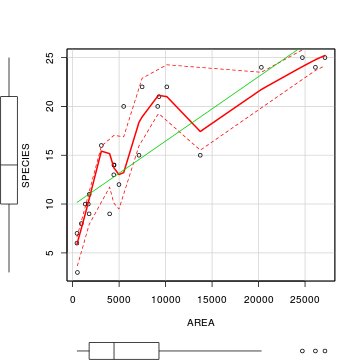
- Focussing on the assumptions of Normality, Homogeneity of Variance and Linearity, is there evidence of violations of these assumptions (y or n)?
- Focussing on the assumptions of Normality, Homogeneity of Variance and Linearity, is there evidence of violations of these assumptions (y or n)?
- Although we could try a logarithmic transformation of the AREA variable, species/area curves are known to be non-linear. We might expect that small clumps would only support a small number of species. However, as area increases, there should be a dramatic increase in the number of species supported. Finally, further increases in area should see the number of species approach an asymptote. Species-area data are often modeled with non-linear functions:
- Try fitting a second order
polynomial trendline
through these data. E.g. Species = α*Area + β*Area2 + c (note that this is just an extension of y=mx+c)
Show code
peake.lm <- lm(SPECIES~AREA+I(AREA^2), data=peake)
- Try fitting a power trendline
through these data. E.g. Species = α(Area)β where the number of Species is proportional to the Area to the power of some coefficient (β).
Show code
peake.nls <- nls(SPECIES~alpha*AREA^beta, data=peake, start=list(alpha=0.1,beta=1))
- Try fitting an asymptotic exponential relationship through these data. E.g. Species = α-βeγArea.
Show code
peake.nls1 <- nls(SPECIES~SSasymp(AREA,a,b,c),data=peake)
- Try fitting a second order
polynomial trendline
through these data. E.g. Species = α*Area + β*Area2 + c (note that this is just an extension of y=mx+c)
- Compare the fit (via AIC, MSresidual and ANOVA) of each of the alternatives (also include the regular linear regression model).
Show code
peake.lmLin <- lm(SPECIES~AREA, data=peake) #calculate AIC for the linear model AIC(peake.lmLin)
[1] 141.1
# calculate mean-square residual of the linear model deviance(peake.lmLin)/df.residual(peake.lmLin)
[1] 14.13
AIC(peake.lm)
[1] 129.5
# calculate mean-square residual of the power model deviance(peake.lm)/df.residual(peake.lm)
[1] 8.602
# assess the goodness of fit between linear and polynomial models anova(peake.lmLin, peake.lm)
Analysis of Variance Table Model 1: SPECIES ~ AREA Model 2: SPECIES ~ AREA + I(AREA^2) Res.Df RSS Df Sum of Sq F Pr(>F) 1 23 325 2 22 189 1 136 15.8 0.00064 *** --- Signif. codes: 0 '***' 0.001 '**' 0.01 '*' 0.05 '.' 0.1 ' ' 1
#calculate AIC for the exponential asymptotic model AIC(peake.nls)
[1] 125.1
# calculate mean-square residual of the exponential asymptotic model deviance(peake.nls)/df.residual(peake.nls)
[1] 7.469
#calculate AIC for the exponential asymptotic model AIC(peake.nls1)
[1] 125.8
# calculate mean-square residual of the exponential asymptotic model deviance(peake.nls1)/df.residual(peake.nls1)
[1] 7.393
# assess the goodness of fit between polynomial and power models anova(peake.nls, peake.nls1)
Analysis of Variance Table Model 1: SPECIES ~ alpha * AREA^beta Model 2: SPECIES ~ SSasymp(AREA, a, b, c) Res.Df Res.Sum Sq Df Sum Sq F value Pr(>F) 1 23 172 2 22 163 1 9.14 1.24 0.28
Model AIC MSresid P-value Species = β*Area + c Compare linear and polynomial
in the box belowSpecies = α*Area + β*Area2 + c Species = α(Area)β Compare power and asymptotic exponential
in the box belowSpecies = α-βeγArea - Create a plot of species number against mussel clump area. Actually, this might be a good point to plot each of the competing models on separate sub-figures.
Hence we will go through the process of building up the four sub-figures in a grid in the one larger figure.
- Start by setting up some whole figure (graphics device) parameters. In particular, indicate that the overall figure is going to comprise 2 rows and 2 columns.
Show code
opar<-par(mfrow=c(2,2))
- Setup the margins (5 units on the bottom and left and 0 units on the top and right) and dimensions of the blank plotting space. Also add the raw observations as solid grey dots
Show code
#first plot linear trend opar1 <- par(mar=c(5,5,0,0)) plot(SPECIES~AREA, data=peake, ann=F, axes=F, type="n") points(SPECIES~AREA, data=peake,col="grey", pch=16)
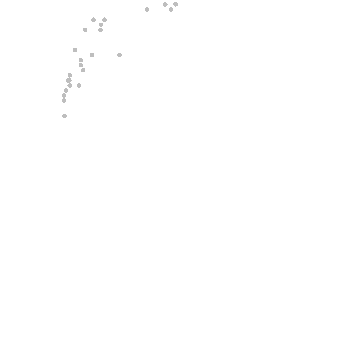
- Use the predict function to generate predicted (fitted) values and 95% confidence intervals for 1000 new AREA values between the minimum and maximum original AREA range. Plot the trend and confidence intervals in solid and dotted lines respectively.
Show code
xs<-with(peake,seq(min(AREA),max(AREA),l=1000)) ys <- predict(peake.lmLin, data.frame(AREA=xs), interval="confidence") points(ys[,'fit']~xs,col="black", type="l")
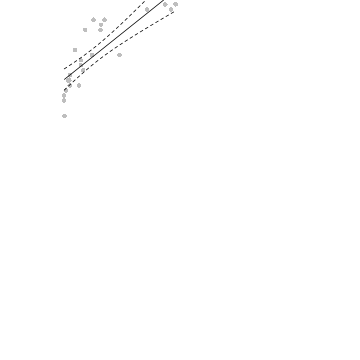
- Add axes, axes titles and a "L" shape axes box to the plot to complete the first sub-figure
Show code
ys <- predict(peake.lmLin, data.frame(AREA=xs), interval="confidence") points(ys[,'fit']~xs,col="black", type="l") points(ys[,'lwr']~xs,col="black", type="l",lty=2) points(ys[,'upr']~xs,col="black", type="l",lty=2) axis(1,cex.axis=0.75) mtext(expression(paste("Clump area",(dm^2))),1,line=3, cex=1.2) axis(2,las=1,cex.axis=0.75) mtext(expression(paste("Number of species (",phantom()%+-%95,"%CI)")),2,line=3, cex=1.2) box(bty="l") par(opar1)
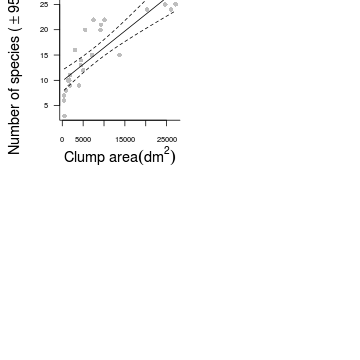
- Complete the second sub-figure (polynomial trend) in much the same manner as the first (linear trend)
Show code
opar <- par(mfrow=c(2,2)) #first plot linear trend opar1 <- par(mar=c(5,5,0,0)) plot(SPECIES~AREA, data=peake, ann=F, axes=F, type="n") points(SPECIES~AREA, data=peake,col="grey", pch=16) xs<-with(peake,seq(min(AREA),max(AREA),l=1000)) ys <- predict(peake.lmLin, data.frame(AREA=xs), interval="confidence") points(ys[,'fit']~xs,col="black", type="l") points(ys[,'lwr']~xs,col="black", type="l",lty=2) points(ys[,'upr']~xs,col="black", type="l",lty=2) axis(1,cex.axis=0.75) mtext(expression(paste("Clump area",(dm^2))),1,line=3, cex=1.2) axis(2,las=1,cex.axis=0.75) mtext(expression(paste("Number of species (",phantom()%+-%95,"%CI)")),2,line=3, cex=1.2) box(bty="l") par(opar1) #second plot polynomial trend opar1 <- par(mar=c(5,5,0,0)) plot(SPECIES~AREA, data=peake, ann=F, axes=F, type="n") points(SPECIES~AREA, data=peake,col="grey", pch=16) xs<-with(peake,seq(min(AREA),max(AREA),l=1000)) ys <- predict(peake.lm, data.frame(AREA=xs), interval="confidence") points(ys[,'fit']~xs,col="black", type="l") points(ys[,'lwr']~xs,col="black", type="l",lty=2) points(ys[,'upr']~xs,col="black", type="l",lty=2) axis(1,cex.axis=0.75) mtext(expression(paste("Clump area",(dm^2))),1,line=3, cex=1.2) axis(2,las=1,cex.axis=0.75) mtext(expression(paste("Number of species (",phantom()%+-%95,"%CI)")),2,line=3, cex=1.2) box(bty="l") par(opar1)
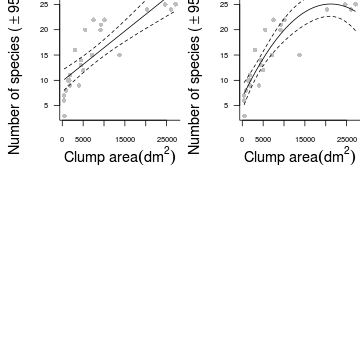
- Start the third (power) model similarly
Show code
opar <- par(mfrow=c(2,2)) #first plot linear trend opar1 <- par(mar=c(5,5,0,0)) plot(SPECIES~AREA, data=peake, ann=F, axes=F, type="n") points(SPECIES~AREA, data=peake,col="grey", pch=16) xs<-with(peake,seq(min(AREA),max(AREA),l=1000)) ys <- predict(peake.lmLin, data.frame(AREA=xs), interval="confidence") points(ys[,'fit']~xs,col="black", type="l") points(ys[,'lwr']~xs,col="black", type="l",lty=2) points(ys[,'upr']~xs,col="black", type="l",lty=2) axis(1,cex.axis=0.75) mtext(expression(paste("Clump area",(dm^2))),1,line=3, cex=1.2) axis(2,las=1,cex.axis=0.75) mtext(expression(paste("Number of species (",phantom()%+-%95,"%CI)")),2,line=3, cex=1.2) box(bty="l") par(opar1) #second plot polynomial trend opar1 <- par(mar=c(5,5,0,0)) plot(SPECIES~AREA, data=peake, ann=F, axes=F, type="n") points(SPECIES~AREA, data=peake,col="grey", pch=16) xs<-with(peake,seq(min(AREA),max(AREA),l=1000)) ys <- predict(peake.lm, data.frame(AREA=xs), interval="confidence") points(ys[,'fit']~xs,col="black", type="l") points(ys[,'lwr']~xs,col="black", type="l",lty=2) points(ys[,'upr']~xs,col="black", type="l",lty=2) axis(1,cex.axis=0.75) mtext(expression(paste("Clump area",(dm^2))),1,line=3, cex=1.2) axis(2,las=1,cex.axis=0.75) mtext(expression(paste("Number of species (",phantom()%+-%95,"%CI)")),2,line=3, cex=1.2) box(bty="l") par(opar1)
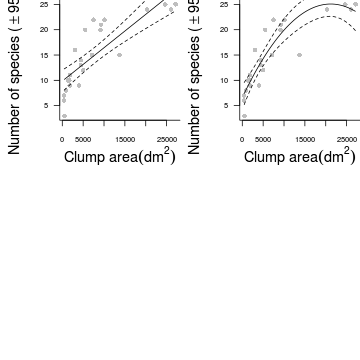
- Estimating confidence intervals is a little more complex for non-linear least squares models as the predict() function does not yet support calculating standard errors or intervals.
Nevertheless, we can do this manually (go R you good thing!).
- Firstly we need to refit the non-linear power model incorporating a function that will be used to specify gradient calculations. This will be necessary to form the basis of SE calculations. So the gradient needs to be specified using the deriv3() function.
- Secondly, we then refit the power model using this new gradient function
Show codeopar <- par(mfrow=c(2,2)) #first plot linear trend opar1 <- par(mar=c(5,5,0,0)) plot(SPECIES~AREA, data=peake, ann=F, axes=F, type="n") points(SPECIES~AREA, data=peake,col="grey", pch=16) xs<-with(peake,seq(min(AREA),max(AREA),l=1000)) ys <- predict(peake.lmLin, data.frame(AREA=xs), interval="confidence") points(ys[,'fit']~xs,col="black", type="l") points(ys[,'lwr']~xs,col="black", type="l",lty=2) points(ys[,'upr']~xs,col="black", type="l",lty=2) axis(1,cex.axis=0.75) mtext(expression(paste("Clump area",(dm^2))),1,line=3, cex=1.2) axis(2,las=1,cex.axis=0.75) mtext(expression(paste("Number of species (",phantom()%+-%95,"%CI)")),2,line=3, cex=1.2) box(bty="l") par(opar1) #second plot polynomial trend opar1 <- par(mar=c(5,5,0,0)) plot(SPECIES~AREA, data=peake, ann=F, axes=F, type="n") points(SPECIES~AREA, data=peake,col="grey", pch=16) xs<-with(peake,seq(min(AREA),max(AREA),l=1000)) ys <- predict(peake.lm, data.frame(AREA=xs), interval="confidence") points(ys[,'fit']~xs,col="black", type="l") points(ys[,'lwr']~xs,col="black", type="l",lty=2) points(ys[,'upr']~xs,col="black", type="l",lty=2) axis(1,cex.axis=0.75) mtext(expression(paste("Clump area",(dm^2))),1,line=3, cex=1.2) axis(2,las=1,cex.axis=0.75) mtext(expression(paste("Number of species (",phantom()%+-%95,"%CI)")),2,line=3, cex=1.2) box(bty="l") par(opar1) #we need to refit the model in order to get gradient calculations from which se can be calculated # this requires that the gradient be specified using the deriv3() function. grad <- deriv3(~alpha*AREA^beta, c("alpha","beta"), function(alpha,beta,AREA) NULL) peake.nls<-nls(SPECIES~grad(alpha,beta,AREA), data=peake,start=list(alpha=0.1,beta=1))
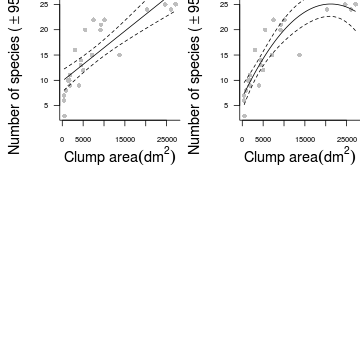
- The predicted values of the trend as well as standard errors can then be calculated and used to plot approximate 95% confidence intervals.
One standard error is equivalent to approximately 68% confidence intervals.
The conversion between standard error and 95% confidence interval follows the formula 95%CI=1.96xSE.
Actually, 1.96 (or 2) is an approximation from large (>30) sample sizes. A more exact solution can be obtained by multiplying the SE by
pt(0.975,df)where df is the degrees of freedom.Show codeopar <- par(mfrow=c(2,2)) #first plot linear trend opar1 <- par(mar=c(5,5,0,0)) plot(SPECIES~AREA, data=peake, ann=F, axes=F, type="n") points(SPECIES~AREA, data=peake,col="grey", pch=16) xs<-with(peake,seq(min(AREA),max(AREA),l=1000)) ys <- predict(peake.lmLin, data.frame(AREA=xs), interval="confidence") points(ys[,'fit']~xs,col="black", type="l") points(ys[,'lwr']~xs,col="black", type="l",lty=2) points(ys[,'upr']~xs,col="black", type="l",lty=2) axis(1,cex.axis=0.75) mtext(expression(paste("Clump area",(dm^2))),1,line=3, cex=1.2) axis(2,las=1,cex.axis=0.75) mtext(expression(paste("Number of species (",phantom()%+-%95,"%CI)")),2,line=3, cex=1.2) box(bty="l") par(opar1) #second plot polynomial trend opar1 <- par(mar=c(5,5,0,0)) plot(SPECIES~AREA, data=peake, ann=F, axes=F, type="n") points(SPECIES~AREA, data=peake,col="grey", pch=16) xs<-with(peake,seq(min(AREA),max(AREA),l=1000)) ys <- predict(peake.lm, data.frame(AREA=xs), interval="confidence") points(ys[,'fit']~xs,col="black", type="l") points(ys[,'lwr']~xs,col="black", type="l",lty=2) points(ys[,'upr']~xs,col="black", type="l",lty=2) axis(1,cex.axis=0.75) mtext(expression(paste("Clump area",(dm^2))),1,line=3, cex=1.2) axis(2,las=1,cex.axis=0.75) mtext(expression(paste("Number of species (",phantom()%+-%95,"%CI)")),2,line=3, cex=1.2) box(bty="l") par(opar1) #we need to refit the model in order to get gradient calculations from which se can be calculated # this requires that the gradient be specified using the deriv3() function. grad <- deriv3(~alpha*AREA^beta, c("alpha","beta"), function(alpha,beta,AREA) NULL) peake.nls<-nls(SPECIES~grad(alpha,beta,AREA), data=peake,start=list(alpha=0.1,beta=1)) ys <- predict(peake.nls, data.frame(AREA=xs)) se.fit <- sqrt(apply(attr(predict(peake.nls1,list(AREA = xs)),"gradient"),1,function(x) sum(vcov(peake.nls1)*outer(x,x)))) opar1 <- par(mar=c(5,5,0,0)) plot(SPECIES~AREA, data=peake, ann=F, axes=F, type="n") points(ys~xs,col="black", type="l") #2*SE equates approximately to 95% confidence intervals #technically it is qt(0.975,df)*SE #therefore this could also be labeled as 90%CI points(ys+2*se.fit~xs,col="black", type="l",lty=2) points(ys-2*se.fit~xs,col="black", type="l",lty=2)
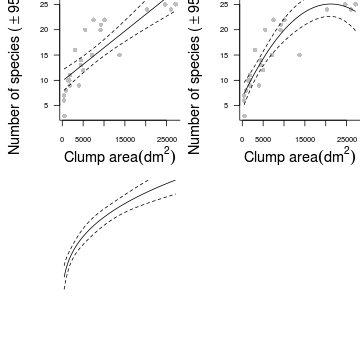
- Finish sub-figure 3 similar to the other two
Show code
opar <- par(mfrow=c(2,2)) #first plot linear trend opar1 <- par(mar=c(5,5,0,0)) plot(SPECIES~AREA, data=peake, ann=F, axes=F, type="n") points(SPECIES~AREA, data=peake,col="grey", pch=16) xs<-with(peake,seq(min(AREA),max(AREA),l=1000)) ys <- predict(peake.lmLin, data.frame(AREA=xs), interval="confidence") points(ys[,'fit']~xs,col="black", type="l") points(ys[,'lwr']~xs,col="black", type="l",lty=2) points(ys[,'upr']~xs,col="black", type="l",lty=2) axis(1,cex.axis=0.75) mtext(expression(paste("Clump area",(dm^2))),1,line=3, cex=1.2) axis(2,las=1,cex.axis=0.75) mtext(expression(paste("Number of species (",phantom()%+-%95,"%CI)")),2,line=3, cex=1.2) box(bty="l") par(opar1) #second plot polynomial trend opar1 <- par(mar=c(5,5,0,0)) plot(SPECIES~AREA, data=peake, ann=F, axes=F, type="n") points(SPECIES~AREA, data=peake,col="grey", pch=16) xs<-with(peake,seq(min(AREA),max(AREA),l=1000)) ys <- predict(peake.lm, data.frame(AREA=xs), interval="confidence") points(ys[,'fit']~xs,col="black", type="l") points(ys[,'lwr']~xs,col="black", type="l",lty=2) points(ys[,'upr']~xs,col="black", type="l",lty=2) axis(1,cex.axis=0.75) mtext(expression(paste("Clump area",(dm^2))),1,line=3, cex=1.2) axis(2,las=1,cex.axis=0.75) mtext(expression(paste("Number of species (",phantom()%+-%95,"%CI)")),2,line=3, cex=1.2) box(bty="l") par(opar1) #we need to refit the model in order to get gradient calculations from which se can be calculated # this requires that the gradient be specified using the deriv3() function. grad <- deriv3(~alpha*AREA^beta, c("alpha","beta"), function(alpha,beta,AREA) NULL) peake.nls<-nls(SPECIES~grad(alpha,beta,AREA), data=peake,start=list(alpha=0.1,beta=1)) ys <- predict(peake.nls, data.frame(AREA=xs)) se.fit <- sqrt(apply(attr(predict(peake.nls1,list(AREA = xs)),"gradient"),1,function(x) sum(vcov(peake.nls1)*outer(x,x)))) opar1 <- par(mar=c(5,5,0,0)) plot(SPECIES~AREA, data=peake, ann=F, axes=F, type="n") points(ys~xs,col="black", type="l") #2*SE equates approximately to 95% confidence intervals #technically it is qt(0.975,df)*SE #therefore this could also be labeled as 90%CI points(ys+2*se.fit~xs,col="black", type="l",lty=2) points(ys-2*se.fit~xs,col="black", type="l",lty=2) points(ys+2*se.fit~xs,col="black", type="l",lty=2) points(ys-2*se.fit~xs,col="black", type="l",lty=2) axis(1,cex.axis=0.75) mtext(expression(paste("Clump area",(dm^2))),1,line=3, cex=1.2) axis(2,las=1,cex.axis=0.75) mtext(expression(paste("Number of species",(phantom()%+-%2~SE),)),2,line=3, cex=1.2) box(bty="l") par(opar1)
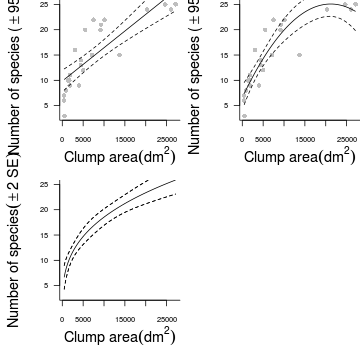
- Sub-figure four (asymptotic exponential) is similar to the power model except that as it already incorporates a gradient function (
SSasymp()), this step is not required.Show codeopar <- par(mfrow=c(2,2)) #first plot linear trend opar1 <- par(mar=c(5,5,0,0)) plot(SPECIES~AREA, data=peake, ann=F, axes=F, type="n") points(SPECIES~AREA, data=peake,col="grey", pch=16) xs<-with(peake,seq(min(AREA),max(AREA),l=1000)) ys <- predict(peake.lmLin, data.frame(AREA=xs), interval="confidence") points(ys[,'fit']~xs,col="black", type="l") points(ys[,'lwr']~xs,col="black", type="l",lty=2) points(ys[,'upr']~xs,col="black", type="l",lty=2) axis(1,cex.axis=0.75) mtext(expression(paste("Clump area",(dm^2))),1,line=3, cex=1.2) axis(2,las=1,cex.axis=0.75) mtext(expression(paste("Number of species (",phantom()%+-%95,"%CI)")),2,line=3, cex=1.2) box(bty="l") par(opar1) #second plot polynomial trend opar1 <- par(mar=c(5,5,0,0)) plot(SPECIES~AREA, data=peake, ann=F, axes=F, type="n") points(SPECIES~AREA, data=peake,col="grey", pch=16) xs<-with(peake,seq(min(AREA),max(AREA),l=1000)) ys <- predict(peake.lm, data.frame(AREA=xs), interval="confidence") points(ys[,'fit']~xs,col="black", type="l") points(ys[,'lwr']~xs,col="black", type="l",lty=2) points(ys[,'upr']~xs,col="black", type="l",lty=2) axis(1,cex.axis=0.75) mtext(expression(paste("Clump area",(dm^2))),1,line=3, cex=1.2) axis(2,las=1,cex.axis=0.75) mtext(expression(paste("Number of species (",phantom()%+-%95,"%CI)")),2,line=3, cex=1.2) box(bty="l") par(opar1) #we need to refit the model in order to get gradient calculations from which se can be calculated # this requires that the gradient be specified using the deriv3() function. grad <- deriv3(~alpha*AREA^beta, c("alpha","beta"), function(alpha,beta,AREA) NULL) peake.nls<-nls(SPECIES~grad(alpha,beta,AREA), data=peake,start=list(alpha=0.1,beta=1)) ys <- predict(peake.nls, data.frame(AREA=xs)) se.fit <- sqrt(apply(attr(predict(peake.nls1,list(AREA = xs)),"gradient"),1,function(x) sum(vcov(peake.nls1)*outer(x,x)))) opar1 <- par(mar=c(5,5,0,0)) plot(SPECIES~AREA, data=peake, ann=F, axes=F, type="n") points(ys~xs,col="black", type="l") #2*SE equates approximately to 95% confidence intervals #technically it is qt(0.975,df)*SE #therefore this could also be labeled as 90%CI points(ys+2*se.fit~xs,col="black", type="l",lty=2) points(ys-2*se.fit~xs,col="black", type="l",lty=2) points(ys+2*se.fit~xs,col="black", type="l",lty=2) points(ys-2*se.fit~xs,col="black", type="l",lty=2) axis(1,cex.axis=0.75) mtext(expression(paste("Clump area",(dm^2))),1,line=3, cex=1.2) axis(2,las=1,cex.axis=0.75) mtext(expression(paste("Number of species",(phantom()%+-%2~SE),)),2,line=3, cex=1.2) box(bty="l") par(opar1) #forth plot trend with standard error opar1 <- par(mar=c(5,5,0,0)) plot(SPECIES~AREA, data=peake, ann=F, axes=F, type="n") points(SPECIES~AREA, data=peake,col="grey", pch=16) xs<-with(peake,seq(min(AREA),max(AREA),l=1000)) ys <- predict(peake.nls1, data.frame(AREA=xs)) se.fit <- sqrt(apply(attr(ys,"gradient"),1,function(x) sum(vcov(peake.nls1)*outer(x,x)))) points(ys~xs,col="black", type="l") points(ys+2*se.fit~xs,col="black", type="l",lty=2) points(ys-2*se.fit~xs,col="black", type="l",lty=2) axis(1,cex.axis=0.75) mtext(expression(paste("Clump area",(dm^2))),1,line=3, cex=1.2) axis(2,las=1,cex.axis=0.75) mtext(expression(paste("Number of species",(phantom()%+-%2~SE),)),2,line=3, cex=1.2) box(bty="l")
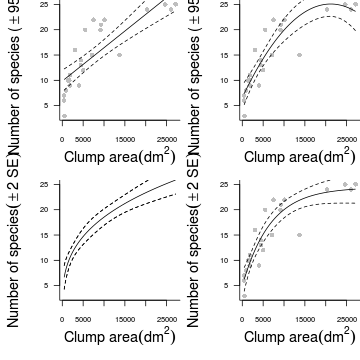
par(opar1)
- Finally, finalize the figure by restoring the plotting (graphics device) parameters
Show code
opar <- par(mfrow=c(2,2)) #first plot linear trend opar1 <- par(mar=c(5,5,0,0)) plot(SPECIES~AREA, data=peake, ann=F, axes=F, type="n") points(SPECIES~AREA, data=peake,col="grey", pch=16) xs<-with(peake,seq(min(AREA),max(AREA),l=1000)) ys <- predict(peake.lmLin, data.frame(AREA=xs), interval="confidence") points(ys[,'fit']~xs,col="black", type="l") points(ys[,'lwr']~xs,col="black", type="l",lty=2) points(ys[,'upr']~xs,col="black", type="l",lty=2) axis(1,cex.axis=0.75) mtext(expression(paste("Clump area",(dm^2))),1,line=3, cex=1.2) axis(2,las=1,cex.axis=0.75) mtext(expression(paste("Number of species (",phantom()%+-%95,"%CI)")),2,line=3, cex=1.2) box(bty="l") par(opar1) #second plot polynomial trend opar1 <- par(mar=c(5,5,0,0)) plot(SPECIES~AREA, data=peake, ann=F, axes=F, type="n") points(SPECIES~AREA, data=peake,col="grey", pch=16) xs<-with(peake,seq(min(AREA),max(AREA),l=1000)) ys <- predict(peake.lm, data.frame(AREA=xs), interval="confidence") points(ys[,'fit']~xs,col="black", type="l") points(ys[,'lwr']~xs,col="black", type="l",lty=2) points(ys[,'upr']~xs,col="black", type="l",lty=2) axis(1,cex.axis=0.75) mtext(expression(paste("Clump area",(dm^2))),1,line=3, cex=1.2) axis(2,las=1,cex.axis=0.75) mtext(expression(paste("Number of species (",phantom()%+-%95,"%CI)")),2,line=3, cex=1.2) box(bty="l") par(opar1) #we need to refit the model in order to get gradient calculations from which se can be calculated # this requires that the gradient be specified using the deriv3() function. grad <- deriv3(~alpha*AREA^beta, c("alpha","beta"), function(alpha,beta,AREA) NULL) peake.nls<-nls(SPECIES~grad(alpha,beta,AREA), data=peake,start=list(alpha=0.1,beta=1)) ys <- predict(peake.nls, data.frame(AREA=xs)) se.fit <- sqrt(apply(attr(predict(peake.nls1,list(AREA = xs)),"gradient"),1,function(x) sum(vcov(peake.nls1)*outer(x,x)))) opar1 <- par(mar=c(5,5,0,0)) plot(SPECIES~AREA, data=peake, ann=F, axes=F, type="n") points(ys~xs,col="black", type="l") #2*SE equates approximately to 95% confidence intervals #technically it is qt(0.975,df)*SE #therefore this could also be labeled as 90%CI points(ys+2*se.fit~xs,col="black", type="l",lty=2) points(ys-2*se.fit~xs,col="black", type="l",lty=2) points(ys+2*se.fit~xs,col="black", type="l",lty=2) points(ys-2*se.fit~xs,col="black", type="l",lty=2) axis(1,cex.axis=0.75) mtext(expression(paste("Clump area",(dm^2))),1,line=3, cex=1.2) axis(2,las=1,cex.axis=0.75) mtext(expression(paste("Number of species",(phantom()%+-%2~SE),)),2,line=3, cex=1.2) box(bty="l") par(opar1) #forth plot trend with standard error opar1 <- par(mar=c(5,5,0,0)) plot(SPECIES~AREA, data=peake, ann=F, axes=F, type="n") points(SPECIES~AREA, data=peake,col="grey", pch=16) xs<-with(peake,seq(min(AREA),max(AREA),l=1000)) ys <- predict(peake.nls1, data.frame(AREA=xs)) se.fit <- sqrt(apply(attr(ys,"gradient"),1,function(x) sum(vcov(peake.nls1)*outer(x,x)))) points(ys~xs,col="black", type="l") points(ys+2*se.fit~xs,col="black", type="l",lty=2) points(ys-2*se.fit~xs,col="black", type="l",lty=2) axis(1,cex.axis=0.75) mtext(expression(paste("Clump area",(dm^2))),1,line=3, cex=1.2) axis(2,las=1,cex.axis=0.75) mtext(expression(paste("Number of species",(phantom()%+-%2~SE),)),2,line=3, cex=1.2) box(bty="l")
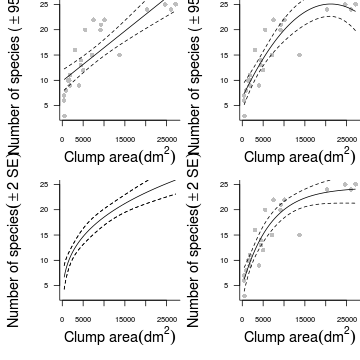
par(opar1) par(opar)
- Start by setting up some whole figure (graphics device) parameters. In particular, indicate that the overall figure is going to comprise 2 rows and 2 columns.
Selecting the most appropriate model to relate the number of species to mussel clump area now becomes a combination of both inferential signals and theoretical biology/ecology. Our knowledge of biology tells us that it is nonsense to suggest that continual mussel clump size increases will result in further linear increases in the number of species encountered. Whilst it is possible that species numbers could reach an maximum at an optimum clump area, the polynomial fit (whilst empirically better than a linear fit - lower AIC and MSresid), is only marginally more suitable. The power and asymptotic exponential models both fit the data substantially (significantly?? - some argue that AIC values 2 units lower are significantly lower) better than either of the linear models. The two non-linear models were not found to differ significantly from one another (in terms of ANOVA or AIC), yet arguably the exponential model that indicates the species numbers rise faster before eventually plateauing off might be considered a more realistic model.
